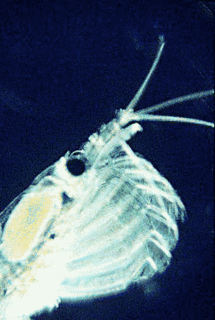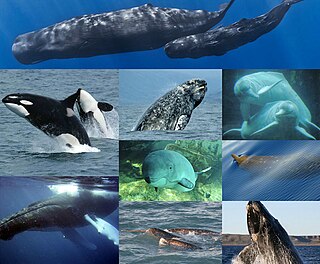
Cetaceans are aquatic mammals constituting the infraorder Cetacea. There are around 89 living species, which are divided into two parvorders. The first is the Odontoceti, the toothed whales, which consist of around 70 species, including the dolphin, porpoise, beluga whale, narwhal, sperm whale, and beaked whale. The second is the Mysticeti, the baleen whales, which have a filter-feeder system, and consist of 15 species divided into 3 families, and include the right whale, bowhead whale, rorqual, pygmy right whale, and gray whale.

Dolphin is a common name of aquatic mammals within the infraorder Cetacea, arbitrarily excluding whales and porpoises. The term dolphin usually refers to the extant families Delphinidae, Platanistidae, Iniidae, and Pontoporiidae, and the extinct Lipotidae. There are 40 extant species named as dolphins.
A genus is a taxonomic rank used in the biological classification of living and fossil organisms, as well as viruses, in biology. In the hierarchy of biological classification, genus comes above species and below family. In binomial nomenclature, the genus name forms the first part of the binomial species name for each species within the genus.

Otters are carnivorous mammals in the subfamily Lutrinae. The 13 extant otter species are all semiaquatic, aquatic or marine, with diets based on fish and invertebrates. Lutrinae is a branch of the weasel family Mustelidae, which also includes badgers, honey badgers, martens, minks, polecats, and wolverines.

Balaenidae is a family of whales of the parvorder Mysticeti that contains two living genera: the right whales, and in a separate genus, the closely related bowhead whale.

Humpback dolphins are members of the genus Sousa. These dolphins are characterized by the conspicuous humps and elongated dorsal fins found on the backs of adults of the species. They are found close to shore along the coast of West Africa and right along the coast of the Indian Ocean from South Africa to Australia. Several institutions have made a proposal to divide the Indo-Pacific species into three distinct species: the Indo-Pacific humpback, the Chinese white dolphin and the Australian humpback dolphin.

The Siphonophorae or Siphonophora, the siphonophores, are an order of the hydrozoans, a class of marine animals belonging to the phylum Cnidaria. According to the World Register of Marine Species, the order contains 188 species. Although a siphonophore may appear to be a single organism, each specimen is in fact a colonial organism composed of small individual animals called zooids that have their own special function for survival. Most colonies are long, thin, transparent floaters living in the pelagic zone. Some siphonophores, such as the venomous Portuguese man o' war and the Indo-Pacific man o' war, superficially resemble jellyfish.

Grimpoteuthis is a genus of pelagic umbrella octopuses known as the dumbo octopuses. The name "dumbo" originates from their resemblance to the title character of Disney's 1941 film Dumbo, having a prominent ear-like fin which extends from the mantle above each eye. There are 13 species recognized in the genus. Prey include crustaceans, bivalves, worms and copepods. The average life span of various Grimpoteuthis species is 3 to 5 years.

A salp or salpa is a barrel-shaped, planktonic tunicate. It moves by contracting, thus pumping water through its gelatinous body, one of the most efficient examples of jet propulsion in the animal kingdom. The salp strains the pumped water through its internal feeding filters, feeding on phytoplankton.
Deania is a genus of long-snouted, deepwater dogfish sharks in the family Centrophoridae.

Scutus is a genus of large sea snails or limpets with the common name "shield shells". These are marine gastropod molluscs in the family Fissurellidae, the keyhole limpets and slit limpets.
Arthur William Baden Powell was a New Zealand malacologist, naturalist and palaeontologist, a major influence in the study and classification of New Zealand molluscs through much of the 20th century. He was known to his friends and family by his third name, "Baden".
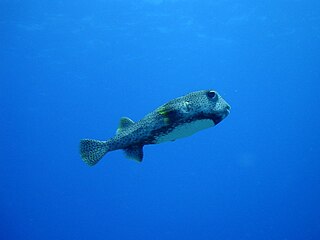
Porcupinefishes or balloonfishes, are any of the various species of the genus Diodon, the type genus of Diodontidae.
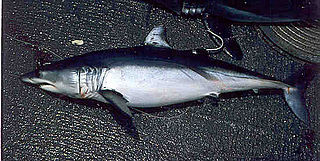
Isurus is a genus of mackerel sharks in the family Lamnidae, commonly known as the mako sharks.

Limaria, the file shells or file clams, is a genus of marine bivalve molluscs in the family Limidae.

Neverita is a genus of medium-sized to large sea snails, marine gastropod molluscs in the family Naticidae, the moon snails

Janthina janthina, common name the violet sea-snail or common violet snail, is a species of holoplanktonic sea snail, a marine gastropod mollusk in the family Janthinidae, the violet snails or purple storm snails.
Liniaxis is a genus of medium-sized sea snails, marine gastropod mollusks in the subfamily Coralliophilinae, the coral snails, within the family Muricidae, the murex snails and rock snails.
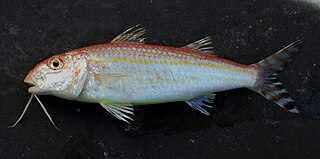
Upeneus is a genus of goatfishes native to the Atlantic, Indian and Pacific oceans.

Lutraria lutraria is a species of large marine bivalve mollusc in the family Mactridae. Its common names include the otter shell and the common otter shell. It occurs in coastal regions of the north east Atlantic Ocean where it lives buried in the sand.


